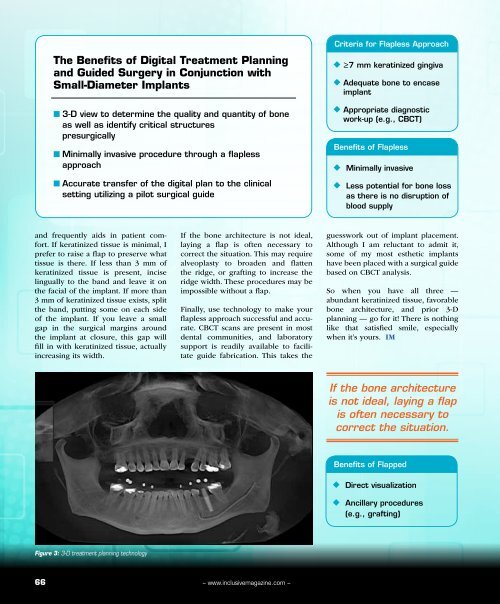PDF Download - Glidewell Dental Labs
PDF Download - Glidewell Dental Labs
PDF Download - Glidewell Dental Labs
Create successful ePaper yourself
Turn your PDF publications into a flip-book with our unique Google optimized e-Paper software.
The Benefits of Digital Treatment Planning<br />
and Guided Surgery in Conjunction with<br />
Small-Diameter Implants<br />
n 3-D view to determine the quality and quantity of bone<br />
as well as identify critical structures<br />
presurgically<br />
n Minimally invasive procedure through a flapless<br />
approach<br />
n Accurate transfer of the digital plan to the clinical<br />
setting utilizing a pilot surgical guide<br />
Criteria for Flapless Approach<br />
u ≥7 mm keratinized gingiva<br />
u Adequate bone to encase<br />
implant<br />
u Appropriate diagnostic<br />
work-up (e.g., CBCT)<br />
Benefits of Flapless<br />
u Minimally invasive<br />
u Less potential for bone loss<br />
as there is no disruption of<br />
blood supply<br />
and frequently aids in patient comfort.<br />
If keratinized tissue is minimal, I<br />
prefer to raise a flap to preserve what<br />
tissue is there. If less than 3 mm of<br />
keratinized tissue is present, incise<br />
lingually to the band and leave it on<br />
the facial of the implant. If more than<br />
3 mm of keratinized tissue exists, split<br />
the band, putting some on each side<br />
of the implant. If you leave a small<br />
gap in the surgical margins around<br />
the implant at closure, this gap will<br />
fill in with keratinized tissue, actually<br />
increasing its width.<br />
If the bone architecture is not ideal,<br />
laying a flap is often necessary to<br />
correct the situation. This may require<br />
alveoplasty to broaden and flatten<br />
the ridge, or grafting to increase the<br />
ridge width. These procedures may be<br />
impossible without a flap.<br />
Finally, use technology to make your<br />
flapless approach successful and accurate.<br />
CBCT scans are present in most<br />
dental communities, and laboratory<br />
support is readily available to facilitate<br />
guide fabrication. This takes the<br />
guesswork out of implant placement.<br />
Although I am reluctant to admit it,<br />
some of my most esthetic implants<br />
have been placed with a surgical guide<br />
based on CBCT analysis.<br />
So when you have all three —<br />
abundant keratinized tissue, favorable<br />
bone architecture, and prior 3-D<br />
planning — go for it! There is nothing<br />
like that satisfied smile, especially<br />
when it’s yours. IM<br />
If the bone architecture<br />
is not ideal, laying a flap<br />
is often necessary to<br />
correct the situation.<br />
Benefits of Flapped<br />
u Direct visualization<br />
u Ancillary procedures<br />
(e.g., grafting)<br />
Figure 3: 3-D treatment planning technology<br />
66<br />
– www.inclusivemagazine.com –

















